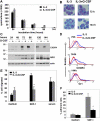Transcription factor Gfi-1 induced by G-CSF is a negative regulator of CXCR4 in myeloid cells
- PMID: 17596540
- PMCID: PMC1988943
- DOI: 10.1182/blood-2007-03-081448
Transcription factor Gfi-1 induced by G-CSF is a negative regulator of CXCR4 in myeloid cells
Abstract
The mechanisms underlying granulocyte-colony stimulating factor (G-CSF)-induced mobilization of granulocytic lineage cells from the bone marrow to the peripheral blood remain elusive. We provide evidence that the transcriptional repressor growth factor independence-1 (Gfi-1) is involved in G-CSF-induced mobilization of granulocytic lineage cells from the bone marrow to the peripheral blood. We show that in vitro and in vivo G-CSF promotes expression of Gfi-1 and down-regulates expression of CXCR4, a chemokine receptor essential for the retention of hematopoietic stem cells and granulocytic cells in the bone marrow. Gfi-1 binds to DNA sequences upstream of the CXCR4 gene and represses CXCR4 expression in myeloid lineage cells. As a consequence, myeloid cell responses to the CXCR4 unique ligand SDF-1 are reduced. Thus, Gfi-1 not only regulates hematopoietic stem cell function and myeloid cell development but also probably promotes the release of granulocytic lineage cells from the bone marrow to the peripheral blood by reducing CXCR4 expression and function.
Figures







Similar articles
-
G-CSF down-regulation of CXCR4 expression identified as a mechanism for mobilization of myeloid cells.Blood. 2006 Aug 1;108(3):812-20. doi: 10.1182/blood-2005-10-4162. Epub 2006 Mar 14. Blood. 2006. PMID: 16537807 Free PMC article.
-
Increased CCAAT enhancer-binding protein epsilon (C/EBPepsilon) expression and premature apoptosis in myeloid cells expressing Gfi-1 N382S mutant associated with severe congenital neutropenia.J Biol Chem. 2006 Apr 21;281(16):10745-51. doi: 10.1074/jbc.M510924200. Epub 2006 Feb 24. J Biol Chem. 2006. PMID: 16500901
-
Granulocyte colony-stimulating factor regulates myeloid differentiation through CCAAT/enhancer-binding protein epsilon.Blood. 2001 Aug 15;98(4):897-905. doi: 10.1182/blood.v98.4.897. Blood. 2001. PMID: 11493431
-
[Clinical relevance of chemokine receptor CXCR4].Postepy Hig Med Dosw (Online). 2012 May 23;66:252-66. doi: 10.5604/17322693.997815. Postepy Hig Med Dosw (Online). 2012. PMID: 22706111 Review. Polish.
-
Peripheral blood stem cell mobilization: the CXCR2 ligand GRObeta rapidly mobilizes hematopoietic stem cells with enhanced engraftment properties.Exp Hematol. 2006 Aug;34(8):1010-20. doi: 10.1016/j.exphem.2006.04.004. Exp Hematol. 2006. PMID: 16863907 Review.
Cited by
-
The coordinated action of G-CSF and ELR + CXC chemokines in neutrophil mobilization during acute inflammation.Blood. 2008 Jan 1;111(1):42-9. doi: 10.1182/blood-2007-07-099648. Epub 2007 Oct 10. Blood. 2008. PMID: 17928531 Free PMC article.
-
Neutrophil mobilization and clearance in the bone marrow.Immunology. 2008 Nov;125(3):281-8. doi: 10.1111/j.1365-2567.2008.02950.x. Immunology. 2008. PMID: 19128361 Free PMC article. Review.
-
Phosphorylated Forms of STAT1, STAT3 and STAT5 Are Expressed in Proliferating but Not Involuted Infantile Hemangioma.Front Surg. 2018 Apr 19;5:31. doi: 10.3389/fsurg.2018.00031. eCollection 2018. Front Surg. 2018. PMID: 29725593 Free PMC article.
-
Treatment with G-CSF reduces acute myeloid leukemia blast viability in the presence of bone marrow stroma.Cancer Cell Int. 2015 Dec 21;15:122. doi: 10.1186/s12935-015-0272-3. eCollection 2015. Cancer Cell Int. 2015. PMID: 26696777 Free PMC article.
-
Are there any new insights for G-CSF and/or AMD3100 in chemotherapy of haematological malignants?Med Oncol. 2015 Dec;32(12):262. doi: 10.1007/s12032-015-0705-9. Epub 2015 Nov 2. Med Oncol. 2015. PMID: 26526720 Review.
References
-
- Lieschke GJ, Grail D, Hodgson G, et al. Mice lacking granulocyte colony-stimulating factor have chronic neutropenia, granulocyte and macrophage progenitor cell deficiency, and impaired neutrophil mobilization. Blood. 1994;84:1737–1746. - PubMed
-
- Liu F, Wu HY, Wesselschmidt R, Kornaga T, Link DC. Impaired production and increased apoptosis of neutrophils in granulocyte colony-stimulating factor receptor-deficient mice. Immunity. 1996;5:491–501. - PubMed
-
- Druhan LJ, Ai J, Massullo P, Kindwall-Keller T, Ranalli MA, Avalos BR. Novel mechanism of G-CSF refractoriness in patients with severe congenital neutropenia. Blood. 2005;105:584–591. - PubMed
Publication types
MeSH terms
Substances
Grants and funding
LinkOut - more resources
Full Text Sources
Molecular Biology Databases
Research Materials

